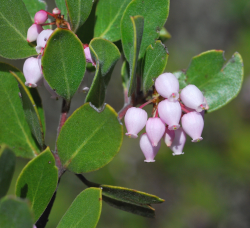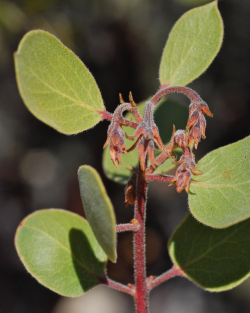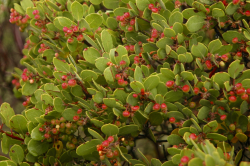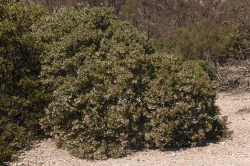
endangered

Ohlone manzanita (Arctostaphylos ohloneana) inflorescence. Lockheed Martin Santa Cruz Facility, Santa Cruz County, CA. Copyright © Jeff Bisbee.

Ohlone manzanita (Arctostaphylos ohloneana), inflorescence with recurved floral bracts. Lockheed Martin Santa Cruz Facility, Santa Cruz County, CA. Copyright © Jeff Bisbee.

Ohlone manzanita (Arctostaphylos ohloneana), with glabrous fruits. Lockheed Martin Santa Cruz Facility, Santa Cruz County, CA. Copyright © Brett Hall.

Ohlone manzanita (Arctostaphylos ohloneana). Lockheed Martin Santa Cruz Facility, Santa Cruz County, CA. Copyright © Brett Hall.



This fact sheet was prepared by Dylan M. Neubauer under award NA04N0S4200074 from the National Oceanic and Atmospheric Administration (NOAA), U.S. Department of Commerce (DOC). The statements, findings, conclusions, and recommendations are those of the authors and do not necessarily reflect the views of the NOAA or the DOC.
© Copyright 2006, Elkhorn Slough Coastal Training Program
Last updated: Sep 6, 2017 17:06
Common Names - Ohlone manzanita
Family - Ericaceae (Heath Family)
State Status - none
Federal Status - none
Habitat
Slopes on siliceous shale outcrops in maritime chaparral–knobcone pine woodland; 440–530 m.
Key Characteristics
Erect shrub to 1–3 m, burl 0; twigs and nascent inflorescence axis sparsely short-non-glandular (and, occasionally, long-glandular hairs), becoming glabrous in age; leaves erect, blades 1.5–3 cm long, 1–1.5 cm wide, elliptic to ovate-elliptic, puberulent and short-glandular-hairy, becoming glabrous in age, surfaces similar, dull, light green, base wedge-shaped; immature inflorescence pendent, floral bracts recurved; fruits depressed-globose, glabrous, stones free; diploid (Kaufmann et al. 2015, Parker et al. 2016).
This species “superficially resembles” Arctostaphylos pungens and A. manzanita, “in terms of its leaves, immature inflorescence, and bracts,” however, the latter two species do not occur in the Santa Cruz Mountains (Vasey and Parker 2008).
Flowering Period
February to March
Reference Population
None
Global Distribution
A Central California endemic restricted to the Lockheed “Chalks” in the northern portion of Ben Lomond Mountain (nw Santa Cruz County) in the Scott Creek watershed of the Santa Cruz Mountains, ca. 4 miles inland from the Pacific Ocean.
Discussion
The species was first discovered in the late 1970s by Santa Cruz botanists James A. West and Randall Morgan in the upper Scott Creek watershed. Its distinctive appearance immediately separated it from the other four manzanita species growing in the general area, though West and Morgan noticed its superficial resemblance to A. pungens, which was not known to occur in the Santa Cruz Mountains. In the mid 1990s, manzanita experts Mike Vasey, Tom Parker, and Jon Keeley were consulted, and they determined that, although there was a superficial similarity between these new shrubs and A. pungens, the new entity lacked the characteristic nascent inflorescence of A. pungens (Vasey and Parker 2008). Chromosomal analysis revealed the new species to be diploid, which separated it from another superficially similar, tetraploid species, A. manzanita (Vasey and Parker 2008). A member of the smaller clade of manzanita species (Wahlert 2005), Vasey and Parker consider it to be a paleoendemic, persisting in a low-nutrient substrate (2008). The species was officially described in 2008 (Vasey and Parker) and given a California Rare Plant Rank of 1B.1 in 2009 (CNPS 2011).
The Central Coast of California is the center of Arctostaphylos diversity (Wahlert et al. 2009), with many local-endemics such as A. ohloneana inhabiting chaparral communities within the summer-fog zone, often in areas with “shallow, rocky and/or nutrient-poor” substrates and relatively frequent, sometimes high-intensity fires (Kauffmann et al. 2015). Many manzanitas depend on fire to reproduce, though species differ as to their strategies. After fire, burl-forming manzanitas can both resprout from the swollen area at the base of the stem and germinate from seeds in the hitherto dormant seed bank, stimulated by chemicals released during combustion. Obligate seeder manzanitas, including A. ohloneana, cannot resprout but are entirely dependent on the seed bank to reproduce (Keeley et al. 2007).
Arctostaphylos ohloneana grows in a “shrub matrix” with burl-forming (and very variable in terms of leaf morphology) A. crustacea subsp. crinita, and obligate seeders A. andersonii [see Factsheet], A. glutinosa [see Factsheet], and A. sensitiva. Because A. ohloneana varies in various characters, it is suspected to be hybridizing to a limited extent with these other species (Vasey and Parker 2009).
Conservation and Threats
This extremely rare endemic grows in an area that is the type locality for another localized endemic manzanita, Arctostaphylos glutinosa [see Factsheet], which is much more abundant than A. ohloneana. Ca. 100 individuals of A. ohloneana in four small populations were documented as of early 2009. The Lockheed fire, which happened later that year, swept through the four-square-km area comprising the known range of this taxon, however some shrubs were spared due to the fast-moving nature of the fire and minimal ground fuels present (West 2015).
Approximately 20 shrubs were observed during two August 2015 surveys, and seed was collected for seedbanking at the UC Santa Cruz Arboretum (Hall 2016). There are still several areas in the upper Scott Creek drainage, both within Lockheed's 5,000 acres and outside that may support additional populations of A. ohloneana (West 2015). Further surveys are required to determine the full extent and status of these populations.
Threats include increased fire-frequency; low population numbers leading to inbreeding depression; road maintenance and vehicle traffic; and, possibly, Phytophthora.
References
Boykin, L. M., M. C. Vasey, V. T. Parker, and R. Patterson. 2005. Two lineages of Arctostaphylos (Ericaceae) identified using the internal transcribed spacer (ITS) region of the nuclear enome. Madroño 52:139–147.
California Native Plant Society (CNPS), Rare Plant Program. 2011. Arctostaphylos ohloneana. Inventory of Rare and Endangered Plants (online edition, v8-02). California Native Plant Society, Sacramento, CA. http://www.rareplants.cnps.org/detail/3366.html [accessed 11 March 2016].
California Natural Diversity Database (CNDDB). 2016. RareFind 5 [Internet]. Arctostaphylos ohloneana. California Department of Fish and Wildlife [accessed 20 February 2016].
Hall, B. 2016. Personal communication [20 March 2015].
Kauffmann, M., T. Parker, and M. Vasey. 2015. Field guide to manzanitas: California, North America, and Mexico. Backcountry Press, Kneeland, CA.
Parker V. T., M. C. Vasey, and J. E. Keeley. 2016. Arctostaphylos ohloneana, in Jepson Flora Project (eds.) Jepson eFlora, http://ucjeps.berkeley.edu/cgi-bin/get_IJM.pl?tid=88878 [accessed on 11 March 2016].
Vasey, M. C. and V. T. Parker. 2008. A newly described species of Arctostaphylos (Ericaceae) from the central California coast. Madroño 55(3):238–243.
Wahlert, G. A., V. T. Parker, and M. C. Vasey. 2009. A phylogeny of Arctostaphylos (Ericaceae) inferred from nuclear ribosomal ITS sequences. Journal of the Botanical Research Institute of Texas 3(2):673–682.
West, J. A. 2015. Traversing Swanton Road. http://arboretum.ucsc.edu/pdfs/traversing-swanton.pdf/ [accessed 13 March 2016].
Reviewers
James A. West, botanist, Santa Cruz County (March 2016); Brett Hall, botanist, Santa Cruz County (March 2016)
